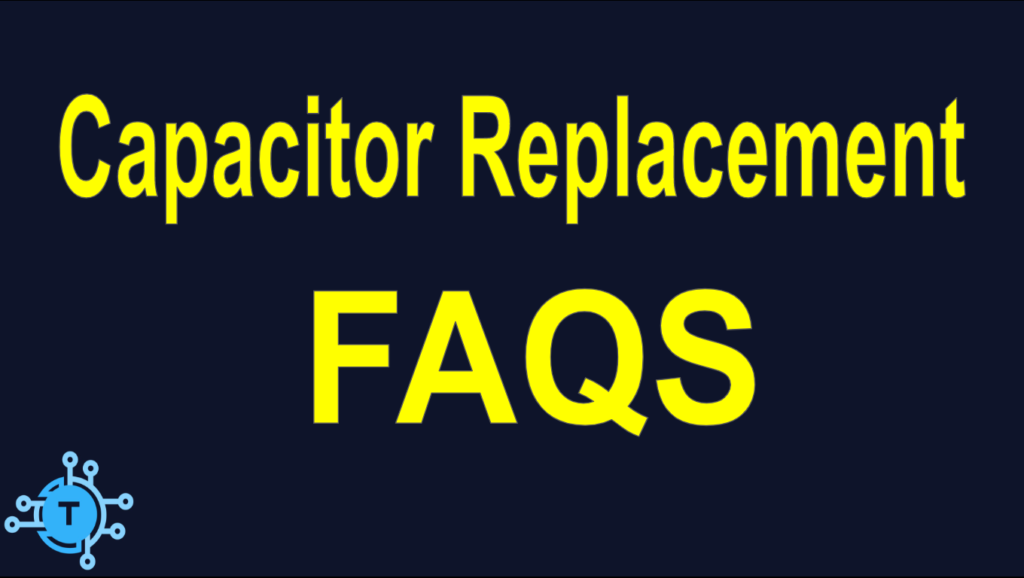
Frequently Asked Questions about Capacitor Replacement is another in a series of FAQS about electricity and electronics that are oriented toward Appliance Technicians and HVAC Technicians.
Important Note
Never attempt to repair circuit boards in appliances or HVAC systems unless you are directly supervised by a licensed professional engineer and doing so under approved ISO and UL processes.
Frequently Asked Questions about Capacitor Replacement
Q. How do capacitors fail?
A. Common failure modes are voltage breakdown, leaky, shorted, high ESR, and loss of capacitance.
Q. How do I identify a failing capacitor?
A. Most capacitors show no physical signs of failure. Electrolytic capacitors often bulge at the top or leak. Sometimes even electrolytic have no physical signs of failure and should be checked with a capacitance or ESR meter. An ESR meter is better for testing electrolytics.
Q. Should I replace a capacitor with the same type/technology?
A. It is best to use the same type, since the capacitor technology selected by the engineers best suits the application.
Q. Can I replace a polarized capacitor with a non-polarized one?
A. Yes.
Q. Can I replace a non-polarized capacitor with a polarized one?
A. In most cases, no.
Q. What types of capacitors are polarized?
A. Electrolytic, which are sub-classed as Aluminum, Tantalum, and Niobium. Super-capacitors are also polarized.
Q. Are motor run or start capacitors polarized?
A. No. They are intended to be used in an AC circuit, for which polarization is not necessary.
Q. What if I need a non-polarized capacitor but can’t find one?
A. You can place two polarized capacitors in series with the negative side of each capacitor (or the positive side of each capacitor) connected to each other. Voltage rating must be observed.
Q. How can capacitors be combined to either increase/decrease capacitance and/or voltage?
A. The next FAQS will give examples.
Q. What is the equivalent capacitance/voltage of two capacitors in parallel?
A. The equivalent capacitance of two capacitors in parallel is the sum of the individual capacitances. The final voltage rating is equal to the lowest rating of the two capacitors. Polarity should be observed.
Q. What is an example two capacitors in parallel to make one capacitor?
A. Suppose you need a 100uF capacitor, at 100v rating. You only have two 47uF capacitors, one is a 100v capacitor and the other one is a 150v capacitor. You can put them in parallel to each other and have the equivalent of a 94uF capacitor @ 100v, which is within the typical 10% tolerance of most electrolytic capacitors. For polarized caps, the positive side of each cap should be connected together.
Q. What is the equivalent capacitance/voltage of two capacitors in series?
A. The equivalent capacitance of two capacitors in series is always less than the lowest value capacitor. The final capacitance is the product over the sum, or Cfinal = (C1xC2)/(C1+C2). The final voltage is the sum of the voltages. For polarized caps, the positive side of one cap should be connected to the negative side of the other cap.
Q. If you have two capacitors in series and they don’t have the same value, which capacitor has the highest voltage drop across it?
A. The lowest value capacitor has the highest capacitive reactance of the two. Thus it has the highest impedance. Since the highest impedance in a series circuit has the highest voltage drop across it, the lowest value (in uF) capacitor has the highest voltage drop of the two capacitors. THIS IS AN IMPORTANT CONSIDERATION WHEN CONSIDERING THE VOLTAGE RATING OF CAPACITORS PLACED IN SERIES.
Q. What is an example two capacitors in series to make one capacitor?
A. Suppose you need a 47uF capacitor, at 100v rating. You only have two 100uF capacitors, both rated at 50v. If you put them in series, you have Cfinal = (C1xC2)/(C1+C2), or (100×100)/(100+100) = 10,000/200 = 50uF @ 100v. NOTE: ALTOUGH THE FINAL VOLTAGE RATING IS 100V, DIFFERENT CAPS HAVE DIFFERENT ESRS. AS WELL CAPACITORS OF DIFFERENT VALUES WILL HAVE DIFFERENT VOLTAGE DROPS ACROSS THEM. THIS MEANS THAT THEY MAY NOT CHARGE EVENLY, CAUSING THE VOLTAGE RATING OF ONE CAP TO BE EXCEEDED. IT IS BEST TO USE TWO CAPS EACH WITH A 100V RATING TO BE ASSURED THAT THE VOLTAGE RATING FOR EITHER CAP WON’T BE EXCEEDED.
Q. What are some other considerations when replacing electrolytic capacitors?
A. When possible, try to use one with the same ESR or lower. ESR is important, particularly in power supply applications where a lot of current flows into the capacitors. Low ESR reduces the voltage drop and power dissipation of the capacitor. Also replacement capacitors should be rated with the same or higher temperature, as well as the number of rated hours at that temperature.
Disclaimer
This blog is intended for experienced or supervised technicians. Always take appropriate safety precautions when dealing with live circuits. For informational purposes only. Utilize the concepts in this blog at your own risk. The Tech Circuit or Steve Morrison assumes no responsibility or liability for any errors or emissions in the content of this blog. The information contained in this blog is provided on an as is basis with no guarantees of completeness, accuracy, usefulness, or timeliness. Never attempt to repair circuit boards in appliances or HVAC systems unless you are directly supervised by a licensed professional engineer and doing so under approved ISO and UL processes.
To donate to the Tech Circuit – CLICK HERE
For additional electrical and electronics learning material for field techs, visit our homepage at http://www.TechCircuit.org or our Facebook group at https://www.facebook.com/groups/746823709133603 or our YouTube Channel
at https://www.youtube.com/@TheTechCircuit
TC
We are a participant in the Amazon Services LLC Associates Program, an affiliate advertising program designed to provide a means for us to earn fees by linking to Amazon.com and affiliated sites.
